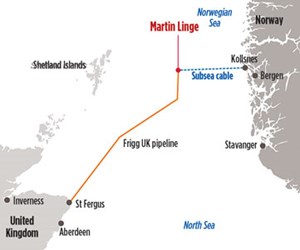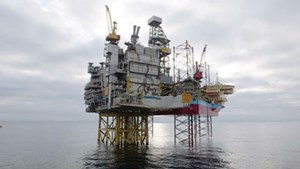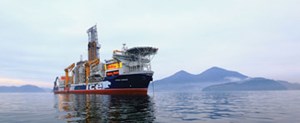Regional Report: Offshore Western Europe
Western Europe, which historically has ranked as one of the leading oil-producing regions in the world, continues to battle its way through one of the worst industry downturns in history. Core fields, including Brent, Forties, Ekofisk and Oseberg, hung on last year as the surrounding area of the North Sea hit an all-time drilling low in September. Baker Hughes reported that just 27 rigs were operating in the North Sea at that time. This is the lowest number of working rigs ever recorded in the region since official record-keeping began in 1982.

The region, although rich in resources, has been hampered by high operating costs. Oil & Gas UK, an upstream trade association, reported early last year that the British oil industry, alone, would be forced to eliminate 120,000 jobs by year-end. Ophir Energy also reported plans to cut about 15% of its global workforce in an effort to reduce costs. Consequently, operators have undergone huge improvements related to cost efficiency of late, and operating costs in the region have reportedly been cut in half, from nearly $30/bbl to just over $15/bbl.
Despite staff cuts and tighter budgets, Western Europe’s offshore energy sector is braving the bitter slump. In April, GlobalData reported that operations at approximately 30 North Sea oil and gas projects are expected to begin by 2020. The UK reportedly will lead the way with 19 projects, followed by Norway with 10 and Denmark with one. Total recoverable reserves for these 30 projects is said to stand at about 5.2 Bboe.
Luis Pereira, upstream analyst at GlobalData, said, “Of the 30 upcoming North Sea projects, 22 are crude oil projects and eight are gas projects. Norway will dominate oil production, while the UK will dominate gas production. The key planned projects in the North Sea are expected to contribute around 690,000 bopd to global crude production and about 1,255 MMcfgd to global gas production in 2020.”
UNITED KINGDOM
One of the UK’s foremost offshore projects is Maersk Oil’s Culzean gas-condensate field, situated approximately 155 mi east of Aberdeen, Scotland. Development of the HPHT field—which is said to contain resources estimated at 250–300 MMboe—has progressed considerably this year. In September, the company started drilling the field’s first production well. The well, which was being drilled by the Maersk Highlander jackup, is one of six wells that are to be drilled over the next five years.
According to Maersk Oil, the development’s three topsides will be installed in 2018 and hooked up in 2019. Following hook-up, three of the six production wells will be ready for first gas. Production from the field is then expected to commence for 13 years, with plateau production of about 60,000 to 90,000 boed.
In addition to Culzean, the company operates Flyndre field, a cross-border development that straddles the line between the UK and Norwegian North Sea. It is approximately 182 mi southeast of Aberdeen in Blocks 30/13 and 30/14 of the UK North Sea, and extends into Block 1/5 of the Norwegian North Sea, about 202 mi southwest of Stavanger. The field hit an important milestone in March, when first oil was delivered via pipeline to Repsol Sinopec’s Clyde platform. According to Maersk Oil, peak oil at Flyndre is expected to reach 10,000 bopd, and should produce until at least 2023.
Repsol Sinopec Resources UK (operator, 58.97%) also reported an important milestone at its Montrose Area redevelopment (MAR) in the central North Sea. The company—along with its sole partner Marubeni Oil & Gas UK—delivered first gas from Cayley field in June, just one month after Shaw field was brought onstream nearby. The field is the third and final discovery to be brought onstream during the redevelopment project, which is considered a major capital effort that is expected to significantly enhance the long-term profitability of the area’s infrastructure.
The project includes the development of three new fields—Godwin, Cayley and Shaw—as well as a new bridge-linked production platform (BLP) that is connected to the Montrose Alpha platform. Godwin field has been developed through an extended reach well from the Arbroath platform, while Cayley and Shaw fields have been developed as subsea tie-backs to the BLP.
According to Repsol Sinopec, gross incremental production from the three fields is expected to peak at 40,000 boed. This reportedly will extend the life of the Montrose Area facilities, which were first installed in 1976, to beyond 2030. Overall, the project is likely to bear up to 100 MMboe of additional output.
Also in June, EnQuest reported that production had begun at Kraken field, in the East Shetland basin. The company had originally approved the field’s development in late 2013, but the drop in oil prices impeded plans to begin producing in what is considered one of the world’s costliest regions to pump oil. According to EnQuest, the field’s 13 wells are going onstream in phases, to maximize long-term productivity and value. All of the wells—seven producers and six injectors—have been drilled and completed. Output routes to the Armada Kraken FPSO.
NORWAY
Offshore Norway, oil majors—including Statoil, Total and Lundin Petroleum—have been working to endure the struggles presented by the oil price slump.

Total, which is Norway’s second-largest oil producer, plays a key role in much of the activity taking place offshore Western Europe, and has been developing new ways to make E&P operations more cost-efficient and environmentally friendly. The producer’s Martin Linge platforms are fully-electric and powered by a nearly 100-mi subsea cable connected to Norway’s coast, Fig. 1. This is the longest AC power link in the world. According to the company, eliminating the need for offshore generators allows their facilities to operate with less CO2 emissions.
In March, Lundin Petroleum reported that it had begun drilling appraisal wells at Edvard Grieg and Gohta fields.
Appraisal well 16/1-27 reportedly was being drilled by the semisubmersible drilling rig, Island Innovator, on the southwestern side of Edvard Grieg field. After further resource potential was identified in the area, the well—which was drilled nearly 2 mi west of the Edvard Grieg platform—reportedly was targeting additional gross resources of up to 30 MMboe.
Appraisal well 7120/1-5 was being drilled by the semisubmersible, Leiv Eiriksson, nearly 2.5 mi north of the original Gohta discovery well. This was the second appraisal well to be drilled at Gohta. According to Lundin Petroleum, the well will help demarcate the northeastern extent of the discovery, as well as provide a calibration point for the drilling of a horizontal well, where an extended well test could potentially be carried out.
Development. This year, Statoil also has advanced operations at numerous developments throughout the Norwegian North Sea. The company’s plan for development of Utgard and Byrding fields was approved by authorities in January. Utgard is a gas-condensate field with estimated recoverable volumes of about 56 MMboe. It straddles the Norwegian/UK median line. Byrding is an oil and gas field situated north of Troll field. It contains estimated recoverable volumes of about 11 MMboe. In July, Statoil reported that Byrding had begun producing to Troll C.
In late March, it was announced that Phase 2 of the Johan Sverdrup development would begin. Phase 2 reportedly will build onto the infrastructure established in Phase 1, which consisted of four platforms. During Phase 2, another processing platform will be added to the field center. Additionally, it will include development of the Avaldsnes, Kvitsøy and Geitungen satellite areas. Overall, 28 new wells are expected to be drilled in relation to the Phase 2 development.
Statoil also announced in July that it would proceed with development of the Snefrid Nord gas discovery, not far from Aasta Hansteen field. The discovery, which was struck in 2015, is scheduled to come online in 2019. It will be tied back to Aasta Hansteen. According to Statoil, the NOK 1.2-billion development’s recoverable reserves are estimated at approximately 5 Bcmg, and it is expected to produce an average 4 MMcmgd. It will likely produce for a period of five to six years, overall.

In late June, the company also reported the start of production at Gina Krog field, Fig. 2. The NOK 31-billion development is producing oil into an FSO vessel. The platform is tied in to Sleipner A and utilizes both the processing capacity on the platform, as well as existing pipelines. It will be among the company’s larger developments in the region, with an estimated 225 MMbbl of oil and gas.
Progress was announced at Statoil’s Johan Castberg field in June, as well. The field, which is expected to receive a final investment decision by year-end, is one of the company’s largest projects yet to be developed. Its resource base consists of three oil discoveries—Skrugard, Havis and Drivis—all of which are found in PL 532, about 62 mi north of Snøhvit field in the Barents Sea.
The company will invest approximately NOK 1.15 billion per year for development of the field, which is anticipated to go onstream in 2022. Its overall proven resource volumes have been estimated between 400 MMbbl and 650 MMbbl of oil.
Exploration. Not far from Johan Castberg, Statoil—and partners Eni and Petoro—announced in mid-July that another small discovery had been made at its Blåmann well. The find, situated between Snøhvit and Goliat fields in the Barents Sea, was drilled in PL 849. No oil volumes were encountered; however, gas was discovered in a 75-ft column in the Stø formation. Recoverable volumes are estimated at 2–3 Bscmg, which is approximately 10–20 MMboe. “We were exploring for oil, and this is not the result we were hoping for,” Jez Averty, senior V.P. of exploration in Norway and the UK, said. “However, this gas discovery has the potential to contribute additional resources to the Snøhvit project.”
The discovery reportedly was the second find in the company’s 2017 Barents Sea exploration campaign. The first find was reported in early July at its Kayak well, also in the Johan Castberg licence area. The oil discovery proved resources totaling between 25 MMboe and 50 MMboe.
Faroe Petroleum (operator, 50%) made several announcements in June regarding Brasse field. The company reported preliminary results for the 31/7-2 S appraisal well, which was reportedly targeting a seismic anomaly found more than a mile from the Brasse discovery. The well was drilled to a TD of 8,038 ft and encountered nearly 28 ft of gross oil-bearing Jurassic reservoir. The company reported that the results, based on extensive coring, wireline logs and pressure data, showed that the well had encountered oil in a sand-rich reservoir of very good quality.
Following the well results, the company moved forward with a drill stem test (DST) for further confirmation of well productivity, as well as analysis of the reservoir distribution. Results of the DST were announced in early July. The test reportedly provided clear evidence of a highly prolific reservoir and excellent quality sands with multi-Darcy permeability. Samples taken of the fluid produced during the DST confirm good-quality light crude that is similar to that of nearby Brage field. Following these results, Faroe Petroleum announced that it would be moving forward with the drilling of a sidetrack well, which will aid in more accurately delineating the Brasse structure.
Faroe Petroleum and Statoil reported in June that plans for development and operation of Njord and Bauge fields had officially been approved by authorities. They are considered two of the most important fields on the Norwegian Continental Shelf. It was reported that the Njord A platform and the Njord Bravo FSO will be upgraded to recover the remaining resources of Njord and Hyme fields. Those remaining resources are said to amount to approximately 175 MMboe.
Bauge, however, is a new field development that will be tied into the Njord A platform. The field development concept reportedly includes a subsea template, two oil producers and one water injector. About 73 MMboe are expected to be produced from Bauge.
DENMARK
As a focal point for Denmark’s national energy infrastructure, Tyra field processes 90% of gas produced in the Danish North Sea. However, the field is facing major hurdles, as its facilities approach the end of their operational lives.
According to Maersk Oil, Tyra field will require a full redevelopment to restore its current infrastructure. This includes the gas processing hub and five surrounding satellite fields. The field’s redevelopment is necessary, due to settling of the chalk reservoir, which has caused the platforms to sink by more than 16 ft over the last 30 years.
In January, Maersk Oil announced that it would halt production at Tyra field during fourth-quarter 2018. Martin Rune Pederson, COO at Maersk Oil, explained, “We have not yet found an economically viable solution for full recovery of the remaining resources in Tyra field, and safe decommissioning of Tyra will therefore be commenced with the perspective of ceasing production on Oct. 1, 2018. We will have to reallocate resources from Tyra rebuild planning to engineering work for a detailed plan to discontinue the Tyra field as the Danish hub for gas processing.”
Meanwhile, Wintershall Noordzee reported a major milestone at Ravn field in April, when it announced that the field had achieved first oil. Ravn field is situated in Block 5/06, and produces oil from a depth of about 13,123 ft via a newly-built production platform. Wintershall has been active in the North Sea for more than 50 years; however, Ravn is the first field off of Denmark that the company has brought onstream as operator.
According to the company, the field is being developed in phases, using an “appraisal through development” approach. This allows the company to consistently gather performance data on well productivity and the lateral extent of the reservoir. The additional data subsequently contribute to further field development opportunities.
IRELAND
E&P activity off the coast of Ireland has been fixated primarily on the Porcupine basin, where water depths range from more than 3,600 ft to nearly 10,335 ft. Last year, Statoil’s Corrib gas field reached peak production of 350 MMscfgd, which is equal to 60,000 boed. The field, situated approximately 51.5 mi off of Ireland’s northwestern coast, consists of six subsea wells. In July, Shell announced plans to sell its shares in Shell E&P Ireland Limited, which holds a 45% interest in Corrib gas field. The $1.23-billion transaction was said to represent the company’s exit from Ireland.

Providence Resources—an Irish exploration company with ongoing operations in the Porcupine, Celtic Sea, Kish Bank, Goban Spur and St. George basins—made significant progress in July when drilling commenced in the southern Porcupine
basin. As operator (56%), Providence Resources—along with its partners Capricorn Ireland Limited (30%) and Sosina Exploration Limited (14%)—contracted the Stena IceMAX deepwater drillship (Fig. 3) to drill the 53/6-A well in Frontier Exploration Licence (FEL) 2/14. The well reportedly was being drilled in an effort to further evaluate the vertically stacked Paleocene Druid and Lower Cretaceous Drombeg exploration prospects.
The company also announced in early April that its JV partners had agreed to underwrite and licence 1,800 km2 of new multi-client 3D seismic data over FEL 3/04, in the southern Porcupine basin. The licence is operated by Eni Ireland BV (36.913%), and partners include Providence Resources (26.846%), Repsol Exploracion Irlanda SA (33.557%) and Sosina Exploration Limited (2.684%).
The main objective of the new 3D seismic survey reportedly was to gain further insight into the hydrocarbon potential of the undrilled Lower Cretaceous Dunquin South carbonate exploration prospect. According to Providence Resources, the Dunquin South prospect has ascertained un-risked prospective resources of 3.475 Bboe (Pmean) of hydrocarbons in place. It has been reported that mobilization of the CGG Oceanic Caspian vessel will soon take place, to conduct the data acquisition program.
In addition, it is anticipated that the new data could provide more information about Exxon Mobil’s 44/23-1 exploration well, which was drilled on the adjacent Dunquin North carbonate prospect in 2013. The well had encountered a large residual oil column in a highly porous, over-pressured carbonate reservoir system. The new survey also could aid in assessing the nature and hydrocarbon potential of the 700-km2 Dunquin Ridge, underlying both Dunquin carbonate build-ups. ![]()
- Applying ultra-deep LWD resistivity technology successfully in a SAGD operation (May 2019)
- Adoption of wireless intelligent completions advances (May 2019)
- Majors double down as takeaway crunch eases (April 2019)
- What’s new in well logging and formation evaluation (April 2019)
- Qualification of a 20,000-psi subsea BOP: A collaborative approach (February 2019)
- ConocoPhillips’ Greg Leveille sees rapid trajectory of technical advancement continuing (February 2019)


